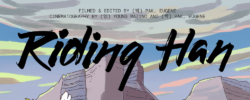In one part of the world, the country breaks into revolution. At the same time in another, a young woman gets elected as the first Asian American to hold her political title. Wherever something is happening, and whatever that something is, someone’s life is being changed.
Wherever a ripple appears on the surface of society, there will be an intrepid Asian American Pacific Islander filmmaker there to make sure it is remembered. From a soul-searching pandemic trip in Arizona to the fight for change in Iran, here are some documentary shorts that hit the screens in 2023.
SHE MARCHES IN CHINATOWN
Watched by: Chen-Yi Wu
In the intimate portrait, “She Marches in Chinatown,” Director Della Chen presents an exceptional image of multigenerational Asian American women, a portrayal unlike any other in the last 70 years. It details how in 1952, Ruby Chow founded the Seattle Chinese Community Girls Drill Team with her fellow local Asian Americans. Chen brings the images of Ruby Chow to life through the utilization of archival footage, historical interviews, and conversations with her contemporaries who warmly reminisce over their shared memories of her. In several interviews shown throughout the film, Chow expresses a fierce passion for preserving and nurturing traditional culture in a fresh and contemporary manner. Adorned in attire inspired by Ming Dynasty and Peking Opera clothing styles, the “kao (靠),” battle armor, and the “hui tou (盔頭),” headgear, symbolize her legendary combat skills and unwavering courage of the woman warrior archetype of Chinese opera.
Although the earliest generations of Chinese immigrants coming to this new land held onto the belief that a girl had no place doing physical activities, Ruby Chow exemplified the belief that “girls can do anything” instead. Beyond establishing the drill team and providing a platform for young adults’ extracurricular pursuits, she shattered political barriers and became the first Asian American to be elected to her county’s council. Her daughter, Cheryl Chow, continued this legacy as an educator and politician, publicly embracing her identity by coming out in 2012. Cheryl’s decision to come out later in life was driven by a profound sense of responsibility to be true to herself, especially in front of the girls she inspired.
Although Ruby and Cheryl Chow have passed away, they left an indelible mark on the lives they touched. “She Marches in Chinatown” serves as a time capsule, offering a glimpse into the past while highlighting the significant strides we have taken in terms of Asian women’s rights in the United States and the preservation of a Chinese heritage community’s history. It is now evident that Asian heroines defy stereotypes – they encompass the roles of mothers, daughters, straight or queer. They are multifaceted.
WHITE GRASS
Watched by: Chen-Yi Wu
Ten-year-old Mogi is the first female jockey in her family, and she has been preparing for the Naadam festival, the most significant racing event in Mongolia, for a while. Mogi’s passion for racing is supported by her mother, who recognizes that this opportunity may not be available to her once she becomes an adult. In “White Grass,” the ethnographic short documentary directed by Korean filmmaker Justin Kim WooSŏk, we are introduced to the daily life of Mogi’s family. The authentic piece showcases the Mongolian lifestyle, their harmonious relationship with nature and livestock, and the looming threat of “dzuds (severe winter conditions)” that pose a danger to their traditional way of life.
Through WooSŏk’s lens, it is not difficult to see his interest in advocating humanity. He highlights individuals discovering, pursuing, becoming, and developing their authentic selves and their full potential, but on the premise that people must live in accordance with nature. Rather than viewing nature as an adversary, WooSŏk emphasizes the need for a partnership between humans and the environment from his subject’s perspective. Mogi once mentioned, “[My father] always reminds me that horses are not machines,” which prompts reflections on the deformation of labor relations in capitalist societies. The film’s ending credit serves as a final gentle reminder from the director – we first recognise the people (names) before we know their titles (position/social status) in order to touch the essence of the world.
A HUI HOU (UNTIL WE MEET AGAIN)
Watched by: Brianna Mei
There’s often this one person in our lives who – no matter if the time spent together with them was one conversation or a lifetime – never ceases to linger in our memories. “A Hui Hou (Until We Meet Again)” is a story of such a bond between director Kainoa Presbitero’s grandmother and a loved one who passed far too early.
“If a moth comes to your house, and sticks around, that’s family coming to say hello to you, that doesn’t want to leave…” is the wisdom that Joyce Hisako Oda passed on to her grandson, Presbitero, and perfectly encapsulates the film’s intertwined themes of life and death, love and loss, and everything in between. The audience is offered a nuanced look at the trauma that emerges at the intersection of love and the finitude of life. The genuinity and honesty of Oda’s storytelling that emphasize her feelings of pain and longing are juxtaposed to a whimsical animation of the moths that allude to the boundlessness of love and the hope of reuniting. Presbitero explains that although Oda’s loss deeply affected her, she “looks back on that part of her life fondly and uses it as a beacon of hope in this part of her life.”
Not only does this film allow Presbitero to archive his elder’s words of wisdom, it also helps him to contemplate how Oda’s experiences affects him, his perception of love, and his relationship with his family’s culture. Altering the connotation of “A Hui Hou” – a Haiwaiian expression used to convey feelings of elation – to embody the bittersweetness of human relationships is Presbitero’s way of paying homage to his culture and authentically expressing his AAPI identity.

(Image Credit: Eugene Pak/Riding Han)
RIDING HAN (RIDING 한)
Watched by: Brianna Mei
It was always a dream of Eugene Pak’s to embark on an outdoor adventure with his loved ones. But the twists and turns of life never presented the right timing until the pandemic hit. Quarantine and a wave of anti-Asian hate crimes created existential crises and catalyzed introspective questions about the Korean American identity for Pak, his brother, Matthew, and his childhood friend, Young. Pak seized the opportunity to press play on his dream when the whole world had pressed pause – together with Matt and Young, he set out to find answers on a 2400 mile long cycling trip along the great divide from Arizona to Canada. And the three musketeers were on their way…
The resulting film documents how physically and mentally draining the travel is for the trio, but most importantly, it illustrates how they find “a simplicity that you cannot replicate,” as Young describes it, amidst the pain. In weal and woe, an even stronger bond of brotherhood is forged and supports them through the process of contemplating their “Han,” which is a key aspect of Korean identities.
While a written quote at the start of the film defines “Han” as the “internalized/unresolved collective grief, resentment, and rage created by deep intergenerational trauma and oppression,” as the film progresses, audiences see how the trio each confronts “Han” differently and develop their own personal insights. Pak depicts the different stages of their growth with the trigrams on the Korean flag that appear one by one, symbolizing the importance of each chapter in their experience.
Their journey of discovery and healing culminates in a second written quote at the very end of the film, “May you use your Han for good.” This message carves a new space in Korean American identity where “Han” can be a source of empowerment for generations to come.
BLOOD OF IRAN خون ایران
Watched by: Chen-Yi Wu
“The place where Mazandaran jungle turns into the lush hills of Gilan, the Chabahar cliffs meet the sea…the place in your mind that remains free.” With these evocative words, Director Alicia Afshar poetically illustrates Iranian geography and transports us to a version of Iran that she and others yearn for. However, she urges us to run alongside her, with a sense of urgency and fear, if we still wish to catch a glimpse of this vanishing paradise. The Iran she envisions is slipping away, perhaps forever. In her powerful documentary “Blood of Iran,” Afshar not only crafts a poignant challenge to the Iranian government’s oppression of women’s rights but also weaves a heartfelt love letter to awakened female allies. Through her unique collage style, this experimental documentary unveils a different face of Iran, transcending stereotypical images from ancient to modern times, offering American audiences a fresh and authentic perspective.
The piece is thoughtfully constructed into three distinct chapters: “Gold,” “Red,” and “Green.” Each chapter offers a glimpse into different eras of Iranian history and the corresponding situation of Iranian women. “Gold” unfolds in a music video style and with talking heads, portraying the golden era when Isfahan flourished as the center of the world, with people enjoying modernity and freedom, sunbathing under the golden rays of progress. In stark contrast, “Red” presents a somber narrative through newsreels and phone videos, revealing the government’s oppressive actions and the people’s outcry. These raw perspectives of the public are brought to the forefront, shedding light on the intense struggles faced by Iranian society. The final chapter, “Green,” adopts a more uplifting tone, as Afshar expresses her heartfelt desire to resurrect the heaven of freedom that once existed. She resolutely calls on all to support and amplify the voices and stories of those fighting for change. “The best way to support them, is just to do what they have been asking us to do since day one, which is be their voice and amplify their stories and share what is happening.” Her sincere call to action resonates deeply, moving audiences to join this unprecedented revolution.
The “Forward Momentum: Documentary Shorts” shorts block screened at the 45th Asian American International Film Festival.

